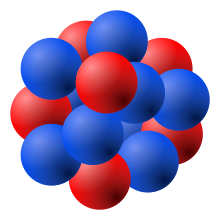Nucleon
Nucleons [nukleˈoːnən] (singular nucleon [ˈnuːkleɔn]; from Latin nucleus "nucleus") are the two types of particles that make up atomic nuclei, namely protons and neutrons.
The experimental finding that the strong interaction observable in atomic nuclei makes no difference between proton and neutron led Heisenberg to the concept of formally considering the two types of particles as two states of one and the same particle type nucleon; the two states differ only by a quantum number which formally appears like the spin quantum number for spin 1/2 and is called isospin. "Nucleon" subsequently became initially the collective name for the two types of particles. The number of nucleons of an atomic nucleus, the mass number, is used for the exact designation of the type of atom (nuclide), such as "oxygen-16" or "iron-56".
In the present (2018) Standard Model, nucleons are defined as those baryons composed exclusively of the light up and down quarks and having isospin 1/2. Apart from the proton and neutron in their ground states, this also includes excited states with such a quark composition, the very short-lived nucleon resonances. If these are counted as separate particle types - as is usual in this case - there are at least 16 and possibly up to 29 nucleons, according to the Particle Data Group (as of 2015). Here, the charge states are not distinguished; proton and neutron are therefore one and the same nucleon in this counting method.
The three quarks mentioned above, the valence quarks, account for only about 5 percent of the mass of a nucleon. The remaining mass is explained by the virtual sea quarks and gluons. According to QCD calculations published in 2018, the exact distribution results in: quarks (constituent quarks and the sea quarks) about 9 % to the mass, the remaining parts come from the kinetic energy of the quarks with about one third, caused by the kinetic energy according to the uncertainty principle since they are "trapped" in a small space, and contributions of the gluons (a field strength contribution of about 37 percent and an anomalous gluon amount of about 23 percent).
In 2008, a group at Forschungszentrum Jülich (Budapest-Marseille-Wuppertal collaboration) succeeded in theoretically calculating the masses of the proton and neutron within the framework of QCD lattice gauge theory with an accuracy of 1 to 2 percent. The simulations were the result of over two decades of research on supercomputers, QCD in lattice gauge formulation and corresponding algorithms, and was error-controlled.

Atomic nucleus with blue neutrons and red protons
Search within the encyclopedia